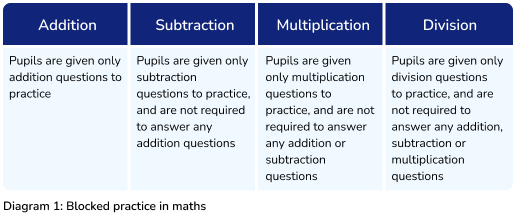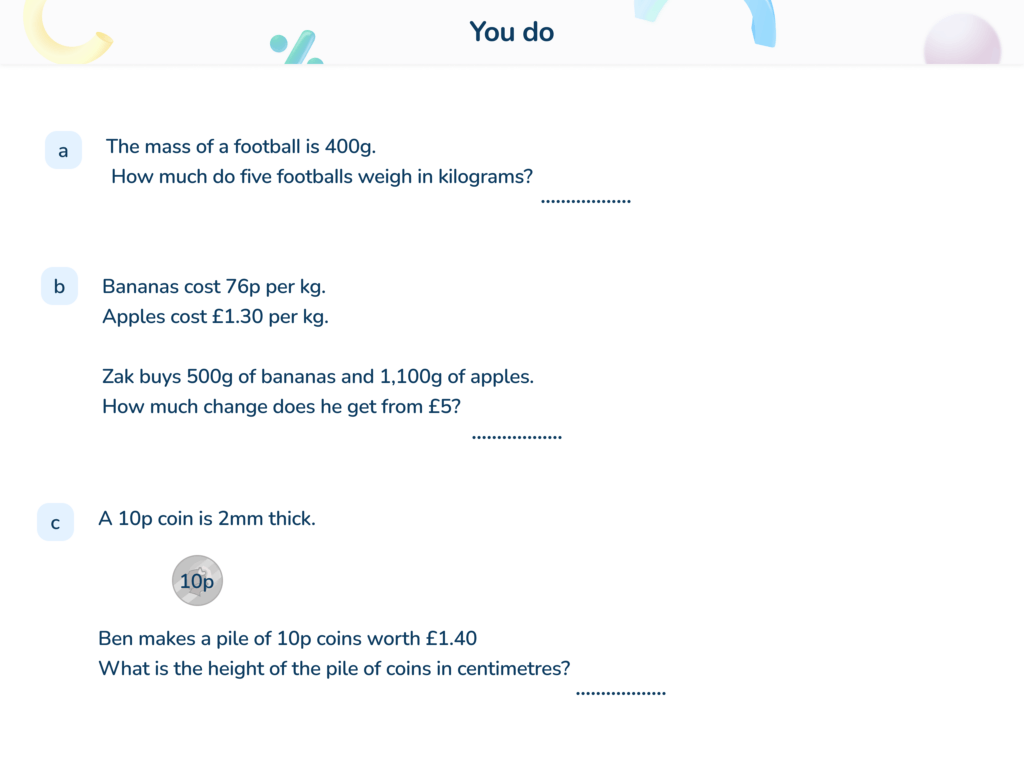Interleaving: What Is It And How Can It Improve Memory And Learning In The Maths Classroom?
Interleaving can be complex to implement in the classroom. It is generally less well understood than other cognitive sciences such as cognitive load theory and retrieval practice. Here we look at how to implement interleaving in the maths classroom effectively and how it compares to blocked practice.
What is interleaving?
Interleaving is an evidence-based teaching method where pupils mix, or interleave, multiple topics while they study to help improve their learning. Problems are arranged so that pupils must use varying strategies to solve them. It is usually referred to in contrast with blocked practice.
What is blocked practice?
Blocked practice involves dedicating extended periods of time to practising a single skill or topic before moving on to the next. It is a focused and repetitive approach to learning that requires the same approach or strategy to solve consecutive problems.
Example of blocked practice
A maths lesson where pupils learn the concept of addition of three-digit numbers is an example of blocked practice. Pupils complete a set of maths problems featuring 10 problem solving questions which require the pupil to add two three-digit numbers together.

Disadvantages of blocked practice
Rohrer et al (1) point out: “Pupils need not learn to choose a strategy when every problem within a practice assignment requires the same strategy… With blocked practice, students know the strategy before they read the problem.”
Because of this, blocked practice – commonly used in most maths lessons or study sessions – is an unengaging practice which does not require deep thinking. It may result in rote responses and is ineffective in presenting pupils with practice tasks.
Firth et al add to this theory:
The attention-attenuation hypothesis suggests that blocking is inferior because attention dwindles when learners see repeated examples of the same type… Mind wandering was found to be at a higher level during the blocked condition compared to the interleaving condition.
Mind wandering is not conducive to learning, but what’s the alternative? Interleaving.
SLT Guide to Choosing Your Maths Scheme of Work
A comprehensive breakdown of the 7 most popular maths schemes of work to help you choose the right maths scheme of work for your school
Download Free Now!What interleaving looks like in practice
Instead of focusing on a single aspect of a topic extensively before moving on to the next, interleaving incorporates multiple aspects of the topic to cause learners to think more deeply about what they are doing.
Interleaving can be used in almost any area of study. The key is to interleave similar content to provide pupils with the opportunity to notice the differences between the content, as well as similarities.
In particular, a well-designed maths curriculum sequence may already group content by similarities. This provides a good starting point for interleaved practice materials in lessons or homework.

Above, the example deliberately includes age-appropriate multiplication and division questions rather than questions which bear a visual resemblance to the focus of the practice task (i.e. two pairs of 2-digit numbers).

Third Space Learning’s maths experts incorporate interleaving in one-to-one maths lessons to improve pupils’ understanding of skills and concepts.
The lesson above requires pupils to use the four operations to solve measurement problems. Each question is deliberately asks children to choose a different strategy to solve the problem.
This may make learning more challenging at the time but results in better long term retention and improve pupils’ ability to choose appropriate strategies.
Benefits of interleaving
- Interleaving promotes inductive learning, allowing pupils to draw general conclusions from observing the significant differences between related content
- It introduces contextual interference, making learning temporarily more challenging but leading to superior retention and transfer performance in the long term
- In maths, interleaving encourages pupils to make choices about the strategies needed, reflecting how real-life uses maths
- It is a more effective alternative to blocked practice which does not encourage strategy choosing and requires less thought
- Enhanced learning and retrieval across a range of subjects
Can you interleave at curriculum level?
Typically, a school’s maths curriculum is a spiral curriculum. This surfaces the question: if interleaving works for practice tasks, could it work over a longer period?
For instance, schools could create an interleaved curriculum where one day pupils are learning about addition, the next 2D shapes and the following day focuses on fractions of amounts.
Using interleaving for entire lessons or topics may reduce the prominence and frequency of contrasts.
Delay a review of information to better recall information rather than a quick review. This is the spaced repetition effect – a feature of retrieval practice.
Research shows that when spacing interferes with discrimination processes, it impairs inductive learning.
This is something to take into consideration when implementing interleaving in secondary or primary curriculum design. It may help to start with collaborative lesson planning when introducing interleaving.
Read more:
Does interleaving work on a longer time scale?
If there is a significant time between interleaved content, pupils are less likely to be able to identify the differences between the content and learn what makes each piece of content unique.
Group content within units to maximise the interleaving possibilities at practice task level. Interleave previous units with material from the current unit if they are sufficiently similar.
Knowledge organisers can be a useful tool for summarising similar topics on one page where pupils can identify patterns, similarities and differences to help them better retain information.
Read more: A Beginner’s Guide To Curriculum Development At Primary School
Why interleaving works
Research shows that interleaving enhances inductive learning.
Inductive learning is the brain’s ability to make general conclusions from specific observations or examples. Firth et al. define it as a form of learning where concepts develop gradually through exposure and experience.
Gathering information, analysing patterns, and making generalisations based on the evidence are all examples of inductive learning.
Inductive learning can happen all the time, including during real-life scenarios, play and other unstructured activities. For example, by listening to adults talk, young children might learn that to talk about things that have already happened, they can add -ed on to the end of words that describe an action.
The reason why interleaving enhances inductive learning is that the juxtaposing of exemplars of different categories that interleaving affords promotes the learning of differences… interleaving is valuable in inductive learning because it allows people to grasp the differences between categories.
Bjork et al
Why interleaving enhances inductive learning: The roles of discrimination and retrieval
In discerning the difference between two types of maths problems about closely related concepts, pupils strengthen the memory associations between the two concepts.
Blocking facilitates processing of similarities within a category, whereas interleaving facilitates processing of differences between categories
Bjork et al
Why interleaving enhances inductive learning: The roles of discrimination and retrieval
Phrases like ‘presentation of closely connected ideas’ and ‘deliberate alternation of items’ are important. Interleaved material should closely connect and teachers should choose topics carefully with particular differences in mind.
If the questions in a practice task are too diverse, there will be fewer opportunities for pupils to notice nuanced differences between the questions.
Firth et al make it clear that manipulating an interleaved list to make contrast more difficult tends to reduce or eliminate the benefit of interleaving.
They also summarise studies that interleave unrelated items have not found this beneficial, such as when Hausman and Kornell (2014) mixed science terms with foreign language vocabulary.
Schorn et al found that contextual interference is surprisingly beneficial to skill learning. It leads to poorer practice performance in the short term but better retention in the long term. They believe interleaving tasks is a good way to introduce contextual interference.
This suggests that interleaving also works because it makes learning a little more difficult for the learner.
For interleaving to boost learning and facilitate long-term retention, there needs to be a similarity between the interleaved items which promotes the identification of differences. This is key to the inductive learning that interleaved practice can promote.
Interleaving versus blocked practice
In a traditional blocked practice approach, students might spend an entire lesson, or unit of work, solving addition practice problems (e.g., 3 + 5, 7 + 2) before moving on to subtraction problem solving (e.g., 9 – 4, 12 – 7) on a separate day.
In contrast, interleaved practice would involve mixing addition and subtraction practice problems together during the same practice session causing the pupil to switch between questions about related concepts.

Pupils’ attitudes to interleaving
Interleaving enhances inductive learning but even when interleaving is beneficial, it may seem counterproductive.
Pupils think that blocked practice is more effective and deliberate practice than interleaving. Perhaps due to how schools embed blocked practice and provide practice tasks. As a result, this is how pupils revise too.
Another explanation is that repetition could lead to a sense of reduced demand and give learners a false perception that blocking is superior to interleaving.
Blocked practice feels easier at the time, and can generate a feeling of success in pupils. But it is less cognitively demanding and less varied. Blocked practice does not cause the pupil to think as hard or allow inductive learning to occur.
If pupils are not required to retrieve information from their long-term memory, it will not root in their long-term memory.
Read more: Explicit instruction and worked examples
Interleaving and the teaching of maths
Using interleaving as a maths teaching strategy can help pupils develop better problem solving skills. It encourages them to apply concepts in varied contexts and enhance their ability to retrieve knowledge more effectively.
Interleaving can improve mathematical understanding and retention by exposing learners to a broader range of problem types and solutions.
Here are some examples and non-examples of interleaving in maths.
7 examples of interleaving in maths
- Addition and Subtraction: practice tasks that combine addition and subtraction problems.
For example, providing a sequence of equations such as 5 + 3 = ___, 10 – 4 =___, 6 + 2 =___, and 12 – ___ = 7.
- Multiplication and Division: practice tasks that include both multiplication and division equations.
For example, providing a sequence of questions such as 4 x 6 = ___, 24 ÷ 3 =,___ 8 x 5 =___, and 32 ÷ ___ = 4.
- Once pupils have learned all 4 operations to an age-appropriate level, interleaved practice could feature addition, subtraction, multiplication and division problems.
5 + 3 = ___, 8 x 5 =___, 12 – ___ = 7, 4 x 6 = ___, 24 ÷ 3 =, ___ 8 x 5 =___, 32 ÷ ___ = 4, 10 – 4 =___,
- Conversion of measurements: practice tasks that require conversions of various units of measurement. This causes pupils to think carefully about whether they are multiplying or dividing by 10, 100 or 1000.
For example, millimetres to centimetres, but also centimetres to meters, and meters to kilometres.
- Time and Money: combine time-telling and other measure-reading questions to help children think about whether they should work in base 60 (for time) or base 10 (for metric measurements).
- Area and Perimeter: interleave geometry concepts by asking pupils to find either the area or the perimeter of a range of shapes.
- Fractions and Decimals: provide practice tasks that interleave fractions and decimals.
For example, pupils could compare and order fractions ( \frac{1}{2}, \frac{1}{4} ) and decimals (0.25, 0.5) or perform operations with both, such as adding \frac{3}{4} and 0.2.
Non-examples of interleaving in maths
Interleaving maths content with content from different subjects such as art, geography or science.
Interleaving practice of different topics within the same subject. For example, a mathematical concept with another mathematical concept which is not related, for example:
- Recognising 2D shapes interleaved with multiplication
- Finding a fraction of a length interleaved with completing a tally chart
- Measuring perimeter interleaved with finding an equivalent fraction
- Converting seconds to minutes interleaved with identifying right angles
How to implement interleaving
- Interleave content and concepts which are alike but also have discernable differences to maximise inductive learning
- Use interleaving in the short term, without spacing, to ensure material is stored and retrieved from long-term memory
- Avoid blocked practice tasks where all the questions require the same thought processes
- Enhance pupils’ metacognition through discussions, allowing them to describe and explain the differences they have discerned during interleaved practice
- Remind pupils when carrying out any self-directed study or revision it can feel like blocked practice is best but interleaving is a more effective way to learn
- Continue to space practice and return to content you have previously taught after a period of time – keep this separate from any interleaved practice
Read more: A Practical Guide To Rosenshine’s Principles of Instruction
FAQs
Pupils carrying out practice activities can use interleaving. If they learn how to carry out division calculations, for example, and already learned techniques for solving addition, subtraction and multiplication questions, the practice activity could interleave questions featuring all 4 operations.
The purpose of interleaving is to enhance learning by preventing the brain from simply recognising patterns, encouraging more active problem-solving, thus strengthening long-term retrieval of information.
Interleaved practice tasks required pupils to continually retrieve information from their long-term memory as they switch between content. They then use this prior knowledge to solve problems – this process occurrs in their short term memory, or working memory. In turn, the active recalling which is prompted by the interleaved material allows the content to become more firmly rooted in their long-term memory.
To make interleaving work in your lessons, create practice tasks which contain a mixture of related topics or problem types within a session, ensuring that the questions are based on previously-learned content.
Sources
Rohrer et al – Interleaved practice improves mathematics learning
Firth et al and Dunlosky et al 2011 – A systematic review of interleaving as a concept learning strategy
Bjork et al – Why interleaving enhances inductive learning: The roles of discrimination and retrieval
Schorn et al – Contextual interference effect in motor skill learning: An empirical and computational investigation
Birnbaum et al – Why interleaving enhances inductive learning: The roles of discrimination and retrieval
DO YOU HAVE STUDENTS WHO NEED MORE SUPPORT IN MATHS?
Every week Third Space Learning’s specialist school tutors support thousands of students across hundreds of schools with weekly online 1 to 1 maths lessons designed to plug gaps and boost progress.
Since 2013 these personalised one to 1 lessons have helped over 150,000 primary and secondary students become more confident, able mathematicians.
Learn how tutors build rapport or request a personalised quote for your school to speak to us about your school’s needs and how we can help.





